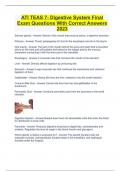Samenvatting
Summary of all theories + important figures of Understanding Prejudice
- Vak
- Instelling
This document entails a summary of all the theories of the course Understanding Prejudice at the UU. At the end of the big table with all the theories, including the core concepts, measures, and origins of prejudice, is an overview of all the important figures, models, and graphs that were present ...
[Meer zien]












